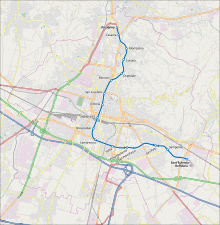Brescia
Brescia is a rich industrial city in Lombardy between Lake Garda, Lake Iseo and the Valtrompia in the foothills of the Alps, about 100 km east of Milan, and the capital of the province of Brescia.
.jpg)

Understand
While the province is rich in scenic and popular tourist destinations, including the shore of the Lake Garda, Brescia itself is less known for tourists. One may that due to its heavily industrialized cityscape it can be found not as interesting compared to other major cities of Lombardy.

Yes, Brescia is famous for its industrial past and for its role as a major manufacturing centre: numerous factories produce weapons (including the famous Beretta pistols) and cutlery/kitchen accessories. This industry has brought the city tremendous wealth and prestige since the 1960s, to the point that an entire second city—the imaginatively named Brescia 2--has sprung up on the south side of the city's original boundaries.
Also, vintage car aficionados flock to Brescia to witness the start and final of the Mille Miglia race, and wine lovers appreciate the local fine Franciacorta wines.
Brescia, however, also has another face, having been founded over three millenniums ago in the times of the Roman Empire, of which several remains can be found, and it remained an important city throughout the early Middle Ages, with the local monastic complex earning a place on the UNESCO World Heritage list (see Longobards in Italy, Places of Power (568–774 A.D.)).
Tourist information
- 🌍 IAT (Tourist Information Office), Piazza del Foro, 6 (Palazzo Martinengo), e-mail: iat.brescia@provincia.brescia.it. Daily 10:00 - 18:00.
Get in
By plane
- 🌍 Aeroporto di Brescia-Montichiari (VBS IATA) (20 km from the city centre in Montichiari). A small airport which is served by charter flights.
The other close airports are:
- Bergamo Airport (aka Milan Orio al Serio, 50 km away, and is served by low-fare flights from all over Europe)
- Verona Airport (50 km away)
- Milano Linate (100 km away)
- Milano Malpensa Airport (150 km away).
By train
You can reach Brescia by any train from the expensive Eurostars to the cheap and slow regionale commuter trains.
By bus
There are 2 bus hubs located near the railway station.
Get around
The compact historical center of the city has a bus system that works well for inhabitants and other commuters.
To get to the outer districts, you can take advantage of Brescia's metro, opened in 2013, making it the smallest city in the world with an underground train system. It features the same driverless automated system as in Copenhagen but with even more spectacular station designs.
Much of the rest of the area, including the Franciacorta wine district and nearby museums such as that of the Mille Miglia automobile race, is more easily accessible by car.
See
Brescia is home to several great museums. However, since it is not a primary tourist city, very few English translations are provided, and even if they are, translations are often so poor that you may prefer to try the Italian explanations.
_int2.jpg)
- 🌍 Monasterio di Santa Giulia, Via dei Musei, 81/b. 16 Jun - Sep: Tu-Su 10:30-19:00; Oct - 15 Jun: Tu-Su 09:30-17:30 (last admission 30 min before closure). A UNESCO World Heritage Site. A former monastery of Santa Giulia (it includes the earlier monastery of San Salvatore) now is a massive museum with a collection of art and archeology dating back more than 10,000 years and exploring the region's history from pre-history to Roman occupation to the Lombard settlement, etc. The museums also contain foundational remnants from various periods of Brescian houses with well preserved beautiful mosaic floors. The permanent collection of religious art is one of the best in northern Italy. Be sure not to miss the Vittoria alata di Brescia (Winged Victory of Brescia) — a true gem of the museum. It's a Greek statue of 3rd century BC, modified in the 1st century with adding the wings — a must see by your own eyes. Also not to be missed a collection of Ritratti romani bronzei di Brescia — a collection of six gilded bronze busts found in 1826 at the Capitolium of ancient Brixia. €10; see Tempio Capitolino (Brixia) for combined tickets.
- Chiesa di Santa Maria in Solario (entry through the museum of the Monasterio di Santa Giulia). Not to be missed for its magnificent frescos. Also there you'd find the Croce di Desiderio (Desiderius’ Cross) a 9th-century wooden processional cross covered with golden foil and adorned with 212 gemstones (50 of them are of antique origin) — the biggest and finest artifact of Lombard goldsmith of the period.

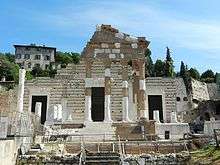
- 🌍 Tempio Capitolino (Brixia. Parco archeologico di Brescia romana), Via dei Musei, 57. 16 Jun - Sep: Tu-Su 10:30-19:00; Oct - 15 Jun: Tu-Su 09:30-17:30 (last admission 30 min. before closure). Said to be one of the best-preserved Roman public complexes in Italy (still it's not like in Pompeii), complete with a forum, amphitheatre and capitolium (Roman temple). Old Roman ruins, the last remains of what once was the city's forum during the Roman Empire, built by the emperor Vespasian. € 8; + Museo di Santa Giulia €15; + Museo di Santa Giulia + Museo delle Armi Luigi Marzoli €20.
- 🌍 Piazza del Foro. Located at the place of the Roman Forum.
- 🌍 Castello di Brescia (Museo delle Armi Luigi Marzoli e Museo del Risorgimento), Via Castello, 9, ☎ +39 030 2977833-834. Museum: 16 Jun - Sep: F-Su 11:00-19:00; Oct - 15 Jun: Th-F 09:00-16:00, Sa-Su 10:00-17:00 (last admission 30 min before closure). Dating to pre-Roman times and last fortified by the Venetian overlords of the 16th century, the city's stronghold houses museums of armory and of the Risorgimento (Italy's first struggles for independence and unification), and provides eccelent views of the Valtrompia, the alps, and the city itself. €4; + Museo di Santa Giulia + Brixia. Parco archeologico di Brescia romana €20.
- 🌍 Chiesa di San Giuseppe, Vicolo San Giuseppe, 5. 16th-century church, inside, there is one of the oldest organs in the world.
- 🌍 Broletto, Piazza Paolo VI. 12th-century Town Hall
- 🌍 Duomo Vecchio (La Rotonda). The unique pre-renaissance church has a massive stone dome and 12th century crucifixes.

- 🌍 Duomo Nuovo (New Cathedral). The city cathedral, built 150 years ago, with the third largest dome in Italy. The local hero is Pope Paul VI (1963–1978), a native Brescian.
- 🌍 Palazzo della Loggia. The city hall and center of regional government, this large and oddly shaped building presides over the city's central square, where you'll often see political demonstrations, concerts, and markets. You can enter the building and look around in the main halls, enjoying the architecture and decor, but it remains primarily functional. The Loggia (lodge) also marks the northern end of the city's retail shopping district.
- 🌍 Case del Gambero (Houses of Shrimp), Corso Palestro. a number of buildings constructed in the mid 16th century probably by Lodovico Beretta between 1550 and 1555. The façades are decorated by a vast cycle of frescoes painted by Lattanzio Gambara, partly lost, partly moved to the Pinacoteca Tosio Martinengo, but still partly on site, albeit mostly severely degraded. The name "Gambero" is after the hotel Gambero, which was located in the vicinity, south of Corso Zanardelli.
- 🌍 Corsia del Gambero (Gambero lane). A nice portico passage built in the 15th century near one of the oldest hotels in Brescia — Locanda del Gambero (now private apartments).
- 🌍 Chiesa di San Giovanni Evangelista. It is one of the oldest churches in Brescia: it was consecrated in the early 5th century.
- 🌍 Torre della Pallata. 32-metre-high 13th-century tower.
- 🌍 Palazzo Martinengo Cesaresco, Via dei Musei, 30, ☎ +39 339 838 4933. M-F 9.00-13.00. A mid-17th-century palace that houses the offices of the province and occasional exhibitions .
- 🌍 Santa Maria dei Miracoli. A Renaissance church with bas-reliefs façade and peristilium. It is considered as one of the finest examples of architecture of this style in Lombardy.
- 🌍 Santi Nazaro e Celso. The church contains the Averoldi Polyptych(1522), a masterwork of Titian.
- 🌍 Piazza della Vittoria. It is a characteristic example of architecture 1930s, designed by Marcello Piacentini, one of the architects of the EUR district in Rome.
- 🌍 Casa Ottelli, Corso Palestro (at the crossing with corso Martiri della Libertà). Built in 1932, at the facade there are two bas-reliefs by Angelo Righetti, the sculptor who was quite famous at the time after he created the sculptures for the Piazza della Vittoria.
- 🌍 Piazza Tebaldo Brusato. Named after a Guelph hero of the defense of Brescia. It was established in 1173 as the first municipal square in the town.
- 🌍 Mercato dei Grani (south of Piazza Tebaldo Brusato). A building with a notable sequence of porticos.
Do
The city's medieval historical center, with shopping districts, open markets (try Via San Faustino and Piazza della Loggia on Saturdays), gelaterias, etc., is a good example of city life untrammeled by tourism.
- 🌍 Teatro Grande (Opera House). Since 1912, the theatre is a national monument of Italy.
- 🌍 Pinacoteca Tosio Martinengo (Palazzo Martinengo da Barco), Piazza Moretto. the building is closed for renovations.
Travelers might find interesting that, due to the city's industry, Brescia is however a major immigrant center. The Via San Faustino neighborhood, with its cheap housing for both immigrants and university students, is an example of cultural integration that you won't find anywhere else in Italy.
- 🌍 Museo Mille Miglia. Until the auto industry made its dirty, cliff-side roads, hairpin turns, and spectator presence far too dangerous, the Mille Miglia, which starts in Brescia, was one of the world's top automobile races. Since it was discontinued as a real race 40 years ago (following numerous driver and spectator deaths), it has continued as a museum of automobile history. The actual race, now a parade of refurbished and custom designed cars that slowly winds its way through 1000 miles of northern Italy, starts in May of each year.
Learn
If you are truly fascinated by the nearly endless parade of invaders that oppressed the city for the past 2000 years—the Romans, the Lombards, the Venetians, and the French, to name the longer-lasting ones—you'll find many historical sites and museums. The city's collection of religious art is housed by several museums. You can buy a yearlong, unlimited pass to the museums for 20 Euro, 15 for students. Brescia has a very old and well regarded university. The medical school, due to its proximity to the large regional hospital, is particularly well regarded. Brescia is not a common or canny destination for study abroad students.
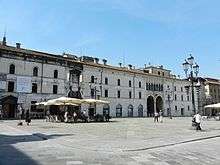

Buy
The historic center of the city has an active shopping district, with numerous clothing and jewelry stores. City residents enjoy strolling through the stretches from the Portici (shopping porticos built literally on top of their similarly styled and utilized Roman antecedents in the heart of the downtown) to Piazza della Loggia.
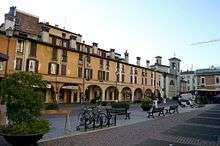
Eat
Try the true "bresciano" food, including casoncelli (called in Brescian dialect "casonsei"), homemade tortellini with beef, served with "Burro versato" (spilled Butter) and sage with sprinkling of Parmigiano. Try the polenta (in winter only) a mush made with durum wheat, Polenta taragna is mixed with homemade cheeses and butter. Try the amazing spiedo (in winter only) roasted larks and pork meat cooked for 6–7 hours in oven with butter and flavours or on grill. It's very typically Bresciano!!!
As with most of Lombard cuisine, Brescian cooking features more beef and butter and more hearty, German-style dishes than the rest of Italy. Excellent pizzerias abound, including Al Teatro (by the theater and portici on the corner of Via Giuseppe Mazzini and Via Giuseppe Zanardelli) and the South-American styled Tempio Inca Pizzeria (Piazzale Arnaldo). Authentic Brescian osterias and trattorias are common on the north side of the city center, but you will find that the best are out of the way and, purposefully, rather hard to find. Try to find the Contrada Santa Chiara, a dark side street parallel to Via San Faustino, where just off Via Dei Musei (close to the Roman Ruins and Santa Giulia), you'll find several highly authentic and inexpensive osterias including Osteria al Bianchi. Cafe culture is just as prominent here as elsewhere, and there are several great coffee and aperitivo spots. Try the Due Stelle on Via San Faustino (also a great restaurant), or any of several cafe/restaurants just north of the Duomos between the Piazza Paulo VI and Via Dei Musei, which feature drinks and unlimited gourmet aperitivo buffets for under 6 Euro.
- 🌍 Amarcord Artisan Piada Restaurant, Via Fratelli Ugoni 16a, ☎ +39 030 42216. Fast food. Has vegan options. Budget.
- 🌍 Osteria Al Bianchi, Via Gasparo da Salò, 32, ☎ +39 030 292328.
- 🌍 Schiaccia Brescia, via Mazzini 5 & Via Cipro 15, ☎ +39 030 280 7252. Fast food joint. Budget.
- 🌍 Trattoria G.A. Porteri, Via Trento, 52, ☎ +39 030 301833.
Drink
Franciacorta wines are easily found. They're excellent, world famous, and very expensive. Try some of the non-DOC labels, which avoid EU regulations in order to preserve centuries-old vineyard traditions.
Brescia is also one of the most night-active city in the whole Italy, because of the industrial wealth. Brescian youths (and Lombardians in general) are famous for partying the night way — every single night. Many hotspots for locals can be found outside the city; in the center try Piazzale Arnaldo on the eastern edge and Borgo Pietro Wuhrer about 5 km east of the center on Via Venezia.
- Viselli's (Near P.le Arnaldo. Look for the crowds and ask somebody). A small bar with an old proprietor who owns the copyright to his cocktails. It's a must in Brescia to try the Viselli's Champagnone (very good but very strong)
- Borgo Wührer: lots of beautiful bars such as Nacio, Hico de puta, BW Cafè, Pappavero, and more.
_in_Brescia_house_Cadeo.jpg)
Sleep
Because it's not a primary tourist destination, Brescia is a bit short on hospitality, especially in the budget range. You'll find a few budget hotels in shadier parts of the city, and some nicer ones close to the train station. For hostels, you're out of luck, and bed and breakfasts are recommended but only if you have a car, as they're usually found in the surrounding towns.
Budget
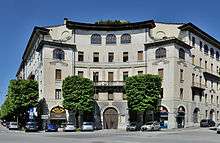
Mid-range
- B&B Cà Del Gando, Via dei Musei, 75, 25121 Brescia, ☎ +39 340 675 3630. Quaint, local B&B. Very attentive owner and situated in the heart of the Brescia historical center. Close to cultural attractions such as museum, roman ruins and nightlife Piazza Arnaldo.
- Ai Ronchi Motor Hotel, Viale della Bornata 22 Brescia,, ☎ +39 030 362061, fax: +39 030 3366315. 4-star hotel located only few steps from city centre of Brescia, on the main road that leads to beautiful Lake Garda. Friendly English-speaking staff.
- Continental Hotel, ☎ +39 030 2582721, fax: +39 030 2583108. Via Martiri della Libertà 267 Roncadelle Brescia. A renovated, modern and functional ambience here along with top quality services and excellent comfort.
- NH Brescia, Viale Stazione, 15, ☎ +39 030 44221. This fairly standard NH is not as fresh as it used to be, but makes up for it with its location next to the train station and the usual NH breakfast buffet.
- AC Hotel Brescia by Marriott, Via Giulio Quinto Stefana 3. In an industrial estate right out of the city. A fairly standard, new and solid AC hotel, with typical upscalish simplicity aimed at business travellers.
- Novotel Brescia Due, Via Pietro Nenni 22. Renovated in 2016 it is a typical Novotel, complete with an outdoor pool, garden and family-oriented amenities, situated in a business park within 15 minutes of the train station.
- Best Western Hotel Master. A solid if slightly uninspired choice in the north of Brescia.
Splurge
- Park Hotel Ca Noa Brescia, ☎ +39 030 398762, fax: +39 030 398764. – Via Triumplina, 66. The Park Hotel Cá Noa is four star hotel with 79 guestrooms, private bath, shower, internet connection, satellite TV and air conditioning. Also available: three meeting rooms and private parking.
- Hotel Vittoria. The closest hotel to the Duomo
- Hotel Ambasciatori. Upscale hotel with lush historizing decoration, reasonably close to the metro.
Go next
Brescia is close to the lakes of Iseo and Garda. You can take trains and buses to the lakes. The ones who travels with a car will find scenic drives there and elsewhere around the city.
Brescia is also so close to other cities more proximate to natural beauty (e.g. Milan, Como, Iseo, Verona, Mantua, and many more), that you may want to just use one of them as a base.
The Franciacorta region south of the Lake Iseo boasts opportunities to taste some of the finest (and most expensive) wines in Italy, as well as tour vineyards and cantinas.
Hiking and biking in the alpine foothills around the city are open to more physically fit and adventurous travellers.
